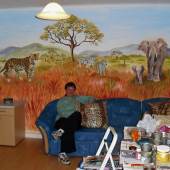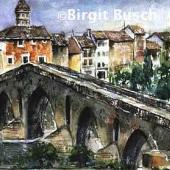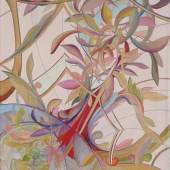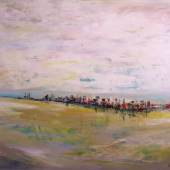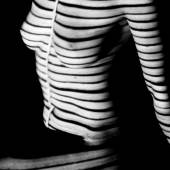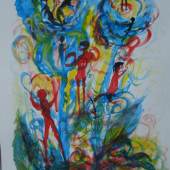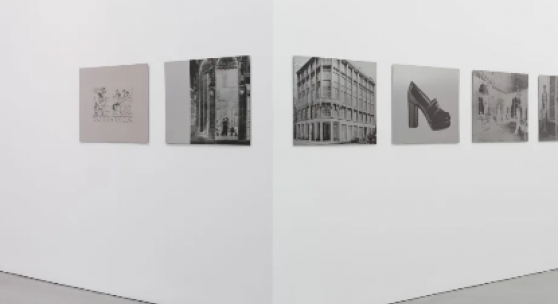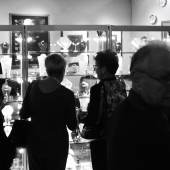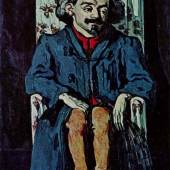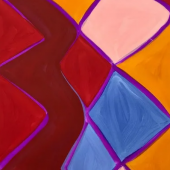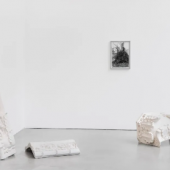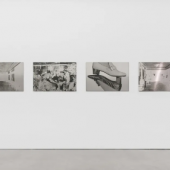JULIAN IRLINGER A SMILE WITH ONE TOOTH JONAS WEICHSEL INTERSTELLAR
-
Ausstellung19.02.2022 - 09.04.2022
While futuristic utopias might be out of fashion, nostalgia itself has a utopian dimension, only it is no longer directed toward the future. Sometimes it is not directed toward the past either, but rather sideways. Svetlana Boym I have been thinking about this exhibition since my first solo show at Galerie Thomas Schulte. The architecture of the historically protected Tuteur Haus, in which the gallery is located, distinguishes this site from other Berlin galleries. Standing in stark contrast to the prefabricated buildings that line Leipziger Strasse, the Tuteur house feels like a time capsule; its generous store-front windows encased in a signature Art Nouveau façade. At the time of my first exhibition at the gallery, I learned that the building was an historical reconstruction of the original Kersten & Tuteur women’s department store, located here in 1913. Originally built in 1886, the owners Jacob Tuteur and Willi Kersten later commissioned architect Hermann Muthesius to modernize the house.
Known for their contemporary interpretation of historical architectural style, architects “Patzschke und Partner” recreated this historic building in the 2000s. Drawing on old photographs, the firm reconstructed characteristics of the building that had been lost to Allied bombings during the Second World War. After the war, the Tuteur House, located in what is now former East Berlin, acted as branch of the Czechoslovakian Embassy, later of Slovakia. During the GDR, the building’s outer appearance was adapted to match the style of the surrounding prefabricated buildings–those same buildings that still line Leipziger Strasse today. These alterations to the Tuteur Haus, however, have been lost to history.
About a year ago, when I started researching the history of the building’s reconstruction, I contacted the owner. Marjorie Nesbitt lives in the US and is a direct descendant of Jacob Tuteur. The gallery forwarded me her e-mail address. My initial email developed into a close exchange with Marjorie and her husband Jack Calaman. We conferred over e-mails, text messages and video calls–these became the starting point for this exhibition.
After the fall of the Berlin Wall, a new law made it possible for Marjorie Nesbitt and her family to file a restitution claim. Though the claim was granted, Marjorie had to fight the German courts for eleven years to have Tuteur Haus returned to her, which was forcibly expropriated from Jacob Tuteur. His business partner, Willi Kersten, had already passed away several years earlier. In the propaganda magazine “Der Stürmer”, a list of the department store’s clients was published and the readers were called upon to denounce them. Tuteur remained in Berlin, taking his own life in 1939 after mounting harassment and intimidation.
Today, shocking information like this is scattered across various digital archives and online newspapers. My works in this exhibition, on the other hand, materialize my personal exchanges with Marjorie and Jack. The couple not only shared with me the tragic story of Jacob Tuteur and his house, but they also sent me documents and artefacts. Among them, the template for the Tree of Life relief that was used in the reconstruction of the building and carved into four points of the facade.
The Tree of Life elements formed the bases for the Corner Space’s four original statues. When the building was restituted, however, only two of the statues were recovered. The Tree of Life templates are the only vestiges of the reconstruction process that Marjorie preserved. I reproduced it twice for the exhibition.
A series of prints on stainless steel show the diagram of a family tree and inverted photographs of the Kersten & Tuteur fashion house. The prints also display details taken from advertisements for the BATA shoe company, which purchased the Tuteur Haus for one Reichsmark (or €4.30) after the building’s violent expropriation.
Photographs in this exhibition present fragments of objects that are connected with the history of the building. One photograph shows an uprooted tree which lies in the Jewish cemetery on Schönhauser Allee. The materiality of the silver gelatine hand prints gives the objects a nostalgic appearance, reminiscent of the reconstructed façade on Tuteur Haus.
When I first contacted Marjorie, I primarily wanted to understand what motivated the project to reconstruct the building. My interest was rooted in my assumption that reconstructions of old buildings on the basis of photographic material, will necessarily lead to a loss in context, as this is neither depicted in the photographs, nor is it apparent in the rebuilt architecture. Nothing indicates the original purpose of the building, because that which was built in between its construction and reconstruction has disappeared.
Philipp Oswalt once described this process as photorealistic reconstruction. Noting in his September 2018 Merkur article “Geschichte wie sie niemals war” (engl. “History as it never was”), that the reconstruction of buildings like the Tuteur Haus have come to represent a kind of identity construction that has swept through Germany since the 1990s. Today, buildings continue to be reconstructed from historic photos taken before the bombs of World War II. It is with this that the fractures of modernism disappear, giving way to an idealized past.
The Tuteur House, however, complicates this observation. Jürgen Patzschke, the architect who managed the reconstruction, referred to the building as “A Smile with One Tooth”: the only house still in a neighborhood, in which almost no buildings survived the bombing of World War II. The motif for a historical reconstruction after Muthesius did not coincide with a general urban plan, but with the private wishes of the restituted family.
-
05.10.2019 - 13.10.2019Am 5. Oktober rollt die FAIR FOR ART Vienna der Kunst zum dritten Mal den roten Teppich aus. Mehr...
-
Der weltweite Ruhm der Dresdner Gemäldegalerie Alte Meister gründet sich auf die hervorragende...
-
Wo Sie die Werke Cézannes besichtigen können: National Gallery, London „Alte...
-
17.11.2023 - 23.06.2024The landmark survey 50 Paintings features works created within the last five years by 50...
-
19.02.2022 - 09.04.2022
GALERIE THOMAS SCHULTE GMBH
CHARLOTTENSTRASSE 24
D–10117 BERLINPHONE: 0049 (0)30 20 60 89 90
FAX: 0049 (0)30 20 60 89 91 0
MAIL@GALERIETHOMASSCHULTE.DEOPENING HOURS:
TUESDAY – SATURDAY
12PM – 6PM
